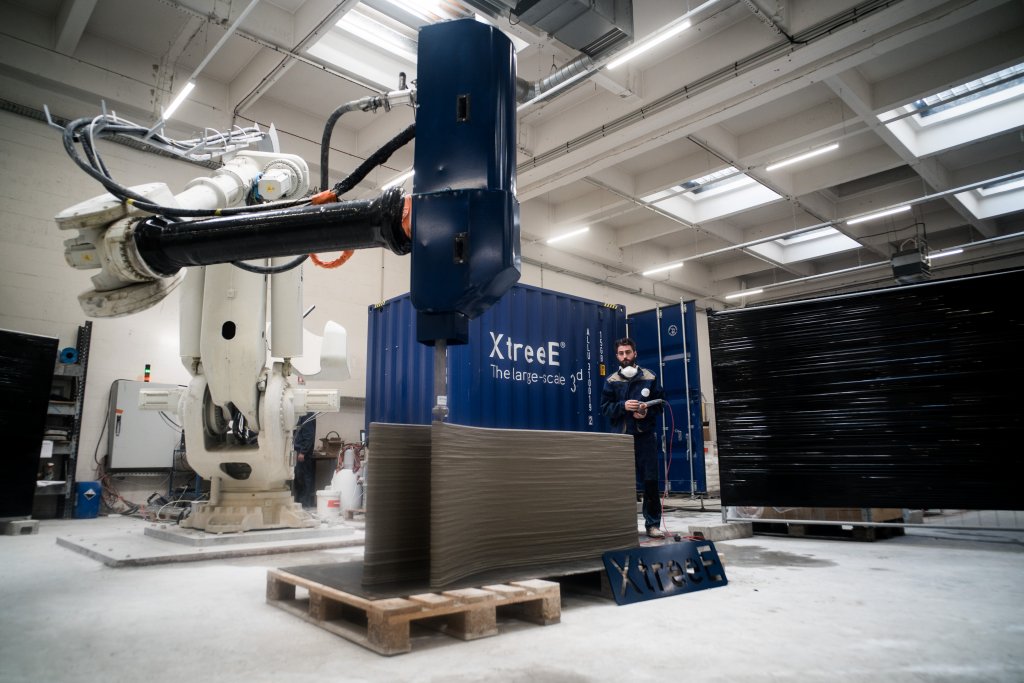French startup XtreeE continues to be a presence in the construction industry with the introduction of 3D printing on the large scale, and now a new production unit in Dubai, United Arab Emirates. The opening of this second site comes on the heels of the XtreeE plant in Paris—as the dynamic company forges ahead in their mission to create a worldwide network of over 50 connected 3D printing units by 2025. Local partner Concreative will be in charge of operations at the Dubai facility while using XtreeE technology.
 Founded in 2015, XtreeE was borne from a collaborative research project at the Paris-Malaquais School of Architecture and the engineering school Arts et Métiers ParisTech—and their technology is now protected by an impressive ten international patents—offering architects the tools to fabricate complex geometries.
Founded in 2015, XtreeE was borne from a collaborative research project at the Paris-Malaquais School of Architecture and the engineering school Arts et Métiers ParisTech—and their technology is now protected by an impressive ten international patents—offering architects the tools to fabricate complex geometries.
With over 20 projects behind them, XtreeE caters to clients and partners in terms of:
- Architectural elements (walls, columns, façade panels)
- Infrastructure (water and heating networks, telecommunication tower, reefs)
- Interior and exterior furniture (benches, chairs, desks, vases)
“XtreeE’s ambition is, above all, environmental. Through these innovations, it is possible to build better and design new products meeting the major challenges of today and tomorrow. While 3D printing makes it possible to reduce both the costs and the overall impact of construction processes, it also makes it possible to manufacture rather unexpected objects, to restore biodiversity,” says Alban Mallet, CEO of XtreeE.
XtreeE projects include:
- Villaprint (to begin in 2020) —in collaboration with Plurial Novilia (Action Logement group), Coste Architectures firm, and the Vicat cement group, they are constructing five ‘social houses’ near Reims, manufactured with both 3D concrete printing and offsite construction. The XtreeE team points out in their recent press release that this type of manufacturing project is a first in France and offers not only greater latitude in design for the architects, but also other benefits of 3D printing such as less use of materials and optimization in production. They predict up to a 70 percent reduction in the amount of concrete used, along with substantially fewer production delays, and greater affordability overall.
- XReef – In a massive, continued, engineering project involving large-scale 3D printing, XtreeE teamed up with Seaboost (Egis Group) and Vicat to produce ‘a new generation of reefs,’ submerged in May, and meant to provide habitats for fish, coral, and algae.
- St@tion4D – working with construction firm Razel-Bec, the pre-caster Saint-Léonard Group, and the architectural firm Aconcept, XtreeE created a customized, portable bench that is being tested as part of the Grand Paris metro project.
XtreeE is involved in increasing productivity in the construction sector, encouraging social progress, and saving resources.
“Concrete is the most consumed material after water. With structurally optimized parts, by positioning the right concrete in the right place, 3D printing offers the possibility to reduce concrete consumption in construction by up to 70 percent,” states the XtreeE team in their recent press release sent to 3DPrint.com. “The production of cement, the main component of concrete, generates 8 percent of global CO2 emissions.
“The removal of formwork also reduces construction waste. Today, XtreeE is active on several fronts, from housing projects to infrastructure. Much remains to be done to transform the construction sector that must meet the requirements of productivity, social progress and save resources.”
After two funding rounds and capital infused via other investors, XtreeE has been able to create a strong business model for the future. In 2020, they plan to roll out their ‘XtreeE Printing as a Service’ digital platform, meant to offer interconnectivity between customers and architects, designers, and engineers—and 3D printers.
XtreeE is currently in discussions to open two other facilities in Asia.
3D printing is not only becoming more widely used in construction, as more and more houses and small structures begin to emerge, but also in materials such as concrete. What do you think of this news? Let us know your thoughts! Join the discussion of this and other 3D printing topics at 3DPrintBoard.com.
[Source / Images: XtreeE press release]Subscribe to Our Email Newsletter
Stay up-to-date on all the latest news from the 3D printing industry and receive information and offers from third party vendors.
You May Also Like
Gorilla Sports GE’s First 3D Printed Titanium Cast
How do you help a gorilla with a broken arm? Sounds like the start of a bad joke a zookeeper might tell, but it’s an actual dilemma recently faced by...
Nylon 3D Printed Parts Made More Functional with Coatings & Colors
Parts 3D printed from polyamide (PA, Nylon) 12 using powder bed fusion (PBF) are a mainstay in the additive manufacturing (AM) industry. While post-finishing processes have improved the porosity of...
$25M to Back Sintavia’s Largest Expansion of Metal 3D Printing Capacity Since 2019
Sintavia, the digital manufacturing company specializing in mission-critical parts for strategic sectors, announced a $25 million investment to increase its production capacity, the largest expansion to its operations since 2019....
Velo3D Initiates Public Offering in a Bid to Strengthen Financial Foundations and Drive Future Growth
Velo3D (NYSE: VLD) has been among a number of publicly traded 3D printing firms that have attempted to weather the current macroeconomic climate. After posting a challenging financial report for 2023,...


































